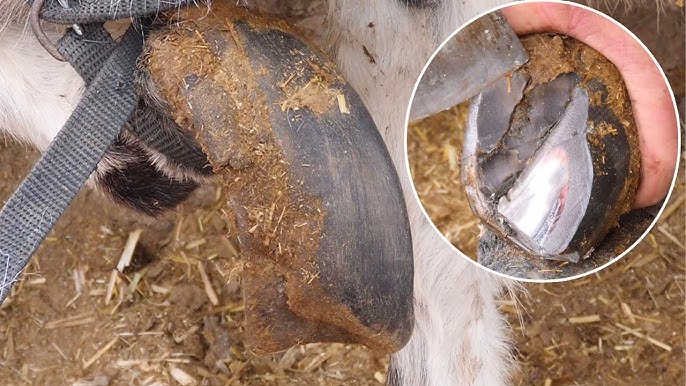Donkeys are hardy animals, but just like horses, they require regular care to stay healthy and comfortable. One of the most important aspects of donkey care is hoof maintenance. Why should you trim a donkey’s hooves? It’s a question that many first-time donkey owners ask, and understanding the reasons behind regular hoof trimming is crucial for maintaining your donkey's overall health. In this article, we'll dive into the reasons why trimming hooves is essential, how to do it properly, and the risks of neglecting hoof care.

A donkey’s hooves are a vital part of its overall well-being. While donkeys may live in more rugged environments than horses, their hooves still need regular attention. Trimming a donkey’s hooves helps maintain proper hoof function, prevents overgrowth, and reduces the risk of serious health issues. Donkey hooves, if left unchecked, can become overgrown, cracked, or infected, which can lead to pain, lameness, or even permanent damage.
Just like humans trim their nails to prevent them from growing too long and causing discomfort, donkeys need the same care for their hooves. The trimming process helps to remove dead hoof tissue and ensure the hooves are in the best shape for walking, running, and performing normal activities.
Donkeys can suffer from a variety of hoof problems if their hooves aren’t regularly trimmed. Some of the most common issues include:
Overgrowth: If a donkey's hooves aren't trimmed regularly, they can grow too long and cause discomfort or difficulty in walking. Overgrown hooves may affect a donkey's posture and gait, leading to potential long-term injuries.
Cracks and Splits: Hooves that are too long or improperly maintained are more prone to cracks and splits. These cracks can trap dirt and bacteria, leading to infections or abscesses. Trimming donkeys' hooves regularly helps to avoid these issues by keeping the hooves at an appropriate length and preventing cracks.
Laminitis and Founder: Laminitis is a painful condition where the hooves become inflamed, often caused by excessive weight or improper hoof care. Neglecting hoof trimming can contribute to the development of laminitis, which can cause permanent damage to the hoof structure and make walking painful for the donkey.
Hoof Rot: Hoof rot is a bacterial infection that can cause the hoof to break down and smell foul. Without regular trimming and cleaning, the hooves become more susceptible to infections, including hoof rot.
The frequency of hoof trimming can vary depending on the donkey’s activity level, environment, and diet. Generally, donkeys should have their hooves trimmed every 6 to 8 weeks. However, donkeys that live on hard, rocky surfaces may wear their hooves down naturally and require less trimming. Conversely, donkeys that live in softer, wetter environments might need more frequent hoof care to avoid overgrowth or infections.
It’s always a good idea to inspect your donkey’s hooves regularly to catch any early signs of issues. If you’re unsure about the right trimming schedule, consulting with a veterinarian or farrier can help you create a routine tailored to your donkey’s specific needs.
If you don’t regularly trim your donkey's hooves, you’re putting their health at serious risk. Hoof neglect can lead to:
Lameness: Painful hooves from overgrowth or infections can cause a donkey to become lame, which can limit their mobility and overall quality of life.
Infections: Overgrown or cracked hooves trap dirt and bacteria, leading to infections that could require medical intervention.
Joint Stress: If a donkey’s hooves are out of alignment due to overgrowth, it can place stress on their joints and lead to long-term issues like arthritis.
Regular hoof trimming helps prevent these serious health issues, ensuring that your donkey can move comfortably and live a long, healthy life.
If you’re planning to trim your donkey's hooves yourself, it’s essential to learn the proper techniques to avoid injury. Here’s a general guide:
Gather the Right Tools: You’ll need hoof nippers, a rasp (hoof file), and a hoof pick to clean the hooves before trimming.
Restrain Your Donkey Safely: Always ensure the donkey is properly restrained. It’s best to have another person assist you, especially if you’re new to trimming hooves.
Inspect the Hoof: Before trimming, look for any signs of cracks, infections, or abnormalities. If you notice any issues, it’s better to consult a veterinarian before trimming.
Trim the Hoof: Carefully trim the hoof in small amounts, focusing on removing excess growth without cutting too deep. The goal is to keep the hoof balanced and at an appropriate length for the donkey’s comfort.
Smooth the Edges: Use a rasp to smooth out any rough edges and ensure the hoof is even.
Clean the Hoof: Use the hoof pick to remove any debris or dirt from the hoof, which can help prevent infections.
If you're not confident about trimming your donkey's hooves yourself, it’s best to consult a professional farrier to ensure the job is done properly.
Regular hoof trimming is a fundamental part of donkey care that should not be overlooked. Trimming a donkey’s hooves helps prevent overgrowth, infections, and lameness while ensuring the donkey’s overall health and comfort. By staying on top of hoof care, you’ll promote better mobility, reduce the risk of painful conditions, and help your donkey lead a longer, happier life.
Baker, G. (2001). The Donkey Care Handbook. A & C Black Publishers.
Herd, P. (2009). Donkey Care: A Complete Guide. Crowood Press.
Squires, E. (2016). The Hoof Care Manual. Routledge.
animal tags:
We created this article in conjunction with AI technology, then made sure it was fact-checked and edited by a Animals Top editor.